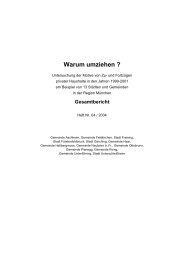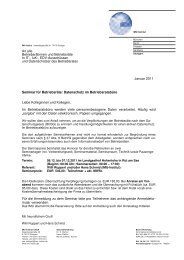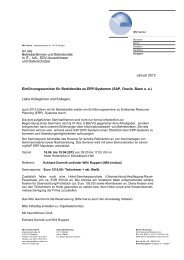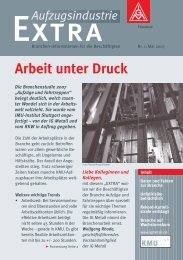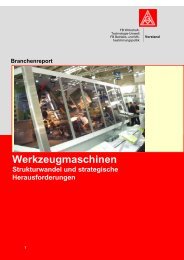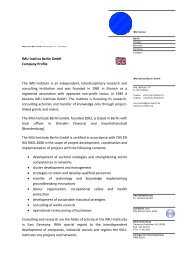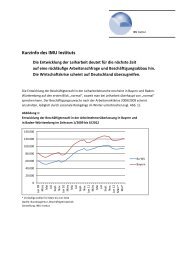Aufzüge und Fahrtreppen - IMU Institut
Aufzüge und Fahrtreppen - IMU Institut
Aufzüge und Fahrtreppen - IMU Institut
Sie wollen auch ein ePaper? Erhöhen Sie die Reichweite Ihrer Titel.
YUMPU macht aus Druck-PDFs automatisch weboptimierte ePaper, die Google liebt.
Industry report<br />
Lifts and escalators – an industry in flux<br />
Dr. Jürgen Dispan 1)<br />
An up-to-date analysis of the situation<br />
and developments in the lift and esca lator<br />
industry was submitted by the <strong>IMU</strong><br />
<strong>Institut</strong>e Stuttgart in the summer of<br />
2007.<br />
Employing a combined workforce of<br />
aro<strong>und</strong> 18,000 and encompassing aro<strong>und</strong><br />
800 different companies, the lift and escalator<br />
sector forms a part of the mechanical<br />
engineering industry. Despite<br />
enormous internationalization pressure<br />
and the closure of production plants here<br />
in Germany as a result of globalized production<br />
concepts over recent decades,<br />
the sector remains a signifi cant mainstay<br />
of the economy. As a sector in which service<br />
has traditionally been of overriding<br />
importance, it may be considered something<br />
of a pioneer of the mechanical engineering<br />
industry in the light of the<br />
transformation brought about by the<br />
general increase in service orientation.<br />
Furthermore, the lift and escalator sector<br />
is an industry characterized by a marked<br />
process of concentration, emanating primarily<br />
from its four major players (Big 4).<br />
There is also a marked process of transformation<br />
<strong>und</strong>er way in terms of employment<br />
in the sector, particularly among<br />
the Big 4, but evident also among the industry’s<br />
small and medium sized enterprises<br />
(SMEs). There is a tendency for permanently<br />
tenured staff to be thinned out<br />
and increasingly replaced by other forms<br />
of employment such as contract work,<br />
while assembly and maintenance work<br />
are being farmed out increasingly to subcontracting<br />
service providers. At the<br />
same time, the holding companies and<br />
other “internal competitors” are playing<br />
an increasingly important role in the<br />
Big 4. Other factors analysed in the Industry<br />
Report include the innovation,<br />
market and service trends taking place in<br />
the sector. The lift and escalator Industry<br />
Report investigates these and a range of<br />
other developments and trends <strong>und</strong>erlying<br />
the structural transformation <strong>und</strong>er<br />
way in the industry, and was compiled by<br />
the <strong>IMU</strong> <strong>Institut</strong>e for the IG Metal trade<br />
union and the Centre for Rationalisation<br />
and Innovation of the German Economy<br />
(RKW).<br />
The objective of the Industry Report is to<br />
provide a well-fo<strong>und</strong>ed inventory of the<br />
status and development of the lift and<br />
escalator industry in Germany taking into<br />
account market and innovation trends,<br />
and to arrive at a statement regarding<br />
corporate strategies. The study is based<br />
on an evaluation of economic and employment-related<br />
data and on industryrelated<br />
publications. By conducting qualitative<br />
interviews, the study also takes<br />
stock of current developments in the industry’s<br />
companies, primarily with a view<br />
to ascertaining the challenges facing the<br />
industry and its players, and elaborates<br />
points of approach for securing Germany’s<br />
position as an industrial location and<br />
1) <strong>IMU</strong> <strong>Institut</strong>e Stuttgart<br />
32 LIFT-REPORT 33. Jahrg. (2007) Heft 6<br />
© DiskArt 1988



